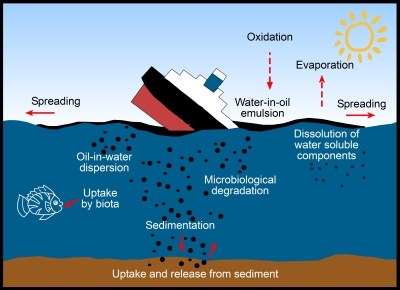L'altération des hydrocarbures à la surface de l'eau - Aperçu (en anglais)
Weathering of Oil on the Water Surface - Overview
Oil spilled at sea undergoes a multitude of physical and chemical changes, some of which lead to the disappearance of oil from the sea surface whereas others promote its persistence. These changes are altogether called weathering processes. They may act simultaneously but they also change over time. The weathering processes determine the behaviour of the oil spill, its spread and thickness, as well as its future locations.
The figure below summarises the main processes that cause an oil to weather.
The speed and relative importance of the weathering processes depend on factors such as the quantity and type of oil, the prevailing weather and sea conditions, and whether the oil remains at sea or is washed ashore.
Oil spilt at sea undergoes the following weathering processes (click on a term if you want to learn more about the process):

